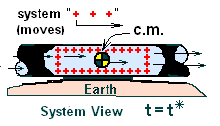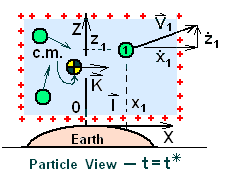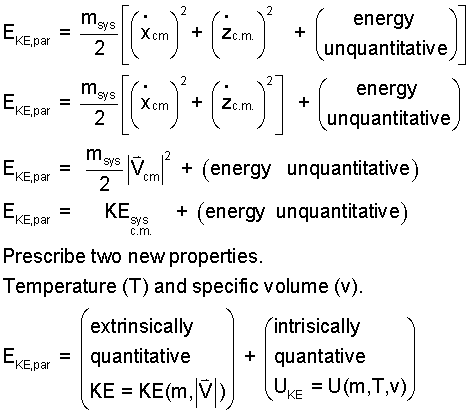| THERMO Spoken Here! ~ J. Pohl © | TOC NEXT ~ 1 |
3.09 Internal Energy
Newton's models of physical reality were the BODY, two BODIES and the EXTENDED BODY. These system models worked very well for planetary motion and for simple, low-friction, events of solids on Earth. The simplicity of there being but two types of energy, kinetic energy and potential, and the fact that their sum was (nearly) always constant, supported the common idea, "energy is conserved." The trend of study of energy these days is less-so "energy is conserved," and more-so "How does energy change."

The sketch (right) depicts a flow of water through a pipe. The boundary of the water (selected as system at the time t* ) is indicated as a dashed ( + + + ) line. The system is constantly "that selected water," consequently the boundary moves. From this perspective, the location of the center of mass of the system and its velocity can be made quantitative for use in describing the kinetic energy and potential energy of the flow. This is called a "bulk" description. However in the attempt to understand friction with its temperature and heat, a perspective "particle behavior" must be instigated.

The idea was to attribute KE and PE at a particle level and then sum those energies. For this discussion, we assume a " High Powered View ." We start with a preposterously long list of assumptions.
To begin we attempt to describe the sum or collective kinetic energy of a collection of " N " particles as one might encounter in a (solid) liquid (or gas). Assume each of the particles has the same mass ( m par). Thus our system mass is:

| (1) 1 |
For now, assume we know the position (in time) of each of the system particles. The vector position of the typical particle is written:

| (2) 2 |
Also assume the center of mass of the particles is known (from the full-system view). Then "particle position" written relative to the position of the system center of mass would be:

| (3) 3 |
To obtain the next equation the positions, position of the center of mass and particle position relative to the center of mass, are written in component form then added.

| (4) 4 |
The position differentiated with respect to time yields the particle velocity.

| (5) 5 |
Our vector, velocity of a particle, is a bit long. But the vector magnitude, the speed, is gotten in the same manner as for simple vectors. To tidy-up a bit, we drop the notational reminder of time dependence, (t) .

| (6)6 |
Our equation now contains two "squares of sums." The principle terms of the squares are x c.m. and z c.m.. By the
We use a simple Cartesian coordinate system and basis, 0, X ~ I , Z ~ K . Particle mass, position and velocity

| (7) 7 |
A large step for engineering occurred when system description was extended to continuum models of physical matter. Systems were realized to be composed of vast numbers of smaller particles. It made sense that particles interior to masses would be governed by Newtons Laws individually among themselves and collectively in relation to the mass, center of mass and its position and velocity. The particles have kinetic energy and potential energy with respect to Earth but also with respect to themselves, each to all others in accord with the molecular, atomic and nuclear force fields and the particles have. A new energy arises with this finer detailed model of matter.
Kinetic and Potential Energies of a Continuum Were a body with its Particle kinetic energy is expected to have the same form as for a point mass (particle mass carries the following superscript, " * ". Also anticipate that the potential energy of N particles can be represented as two parts, the first being interior or intra-system, particle to particle behavior and the other being a system to surroundings contribution - principally a gravity or potential energy with the Earth. "inside to outside" the N particles. but for a particle mass (the superscript " * " denotes "particle"). The "N" particles have kinetic energy:

| (8)8 |
The above expression, though logical, cannot to made quantitative. The particle masses might be specified but it is impossible to state their speeds at any instance of time. Since none of the three terms can be evaluated; it appears we are at an impasse. A macroscopic perspective for fluid systems is needed.
Center of Mass: is a tight, compact perspective for regular solids in classical motion, thoroughly explained in physics and mechanics texts. Here the task of center of mass is messy. Its objective is to use center of mass to extract what might be measures of the three terms of Eqn. 2. The "center of mass concept" applied to solids is tidy. For regular solids, kinetic and potential energy transform cleanly. The energy of the solid sum is that of the density of regular solid geometries. Center of mass of a continua is a nebulous idea. Once energy associated with the center of mass is accounted for in a quasi-solid body manner, there is microscopic kinetic and potential energy un-included by the center of mass perspective. Activity of matter, showing energy, more energy than center of mass activities detail... By center of mass perspectives, the bulk motion energy describe
We don't intend to perform these operations but only to describe them. The center of mass is a moving position in space at which all of the mass can be assume to reside. Thus we sum to obtain that system mass. Next the first moment is used to establish the vector r (t), the location of the cm.

| (9) 9 |
The above idea will locate the center of mass. It's position is named P (t). Next the position of any of the particles is written in two pieces as:

| (10) 10 |
It is the velocity of the particles that is needed. So the above is differentiated.

| (11)11 |
These changes permit the kinetic energy of N particles (which cannot be written) to be written in terms of the center of mass velocity plus a sum over W i, the relative velocities of particles.(IE_4a)

| (12) 12 |
To this point we have expanded the energy of N particles (EN-particles) to be 5 terms.
- Term (i) is the translational kinetic energy of the sum of masses. If the center of mass does not move, this term equals zero.
- Term (ii) is the rotational kinetic energy of the mass of particles. The moment of inertia of the mass is I and its rotation rate is ω is the rotational speed.

| (13) 13 |
The first two terms of the above equation.

| (14) 14 |
An expression representing the collective kinetic energy of a system of particles is a sum of all the individual kinetic energies of the particles.
3.08 Internal Energy
Newton's models of physical reality were the BODY, two BODIES and the EXTENDED BODY. These system models worked very well for planetary motion and for simple, low-friction, events of solids on Earth. The simplicity of there being but two types of energy, kinetic energy and potential, and the fact that their sum was (nearly) always constant, supported the common idea, "energy is conserved." The trend of study of energy these days is less-so "energy is conserved," and more-so "How does energy change."
Premise presently unwritted!